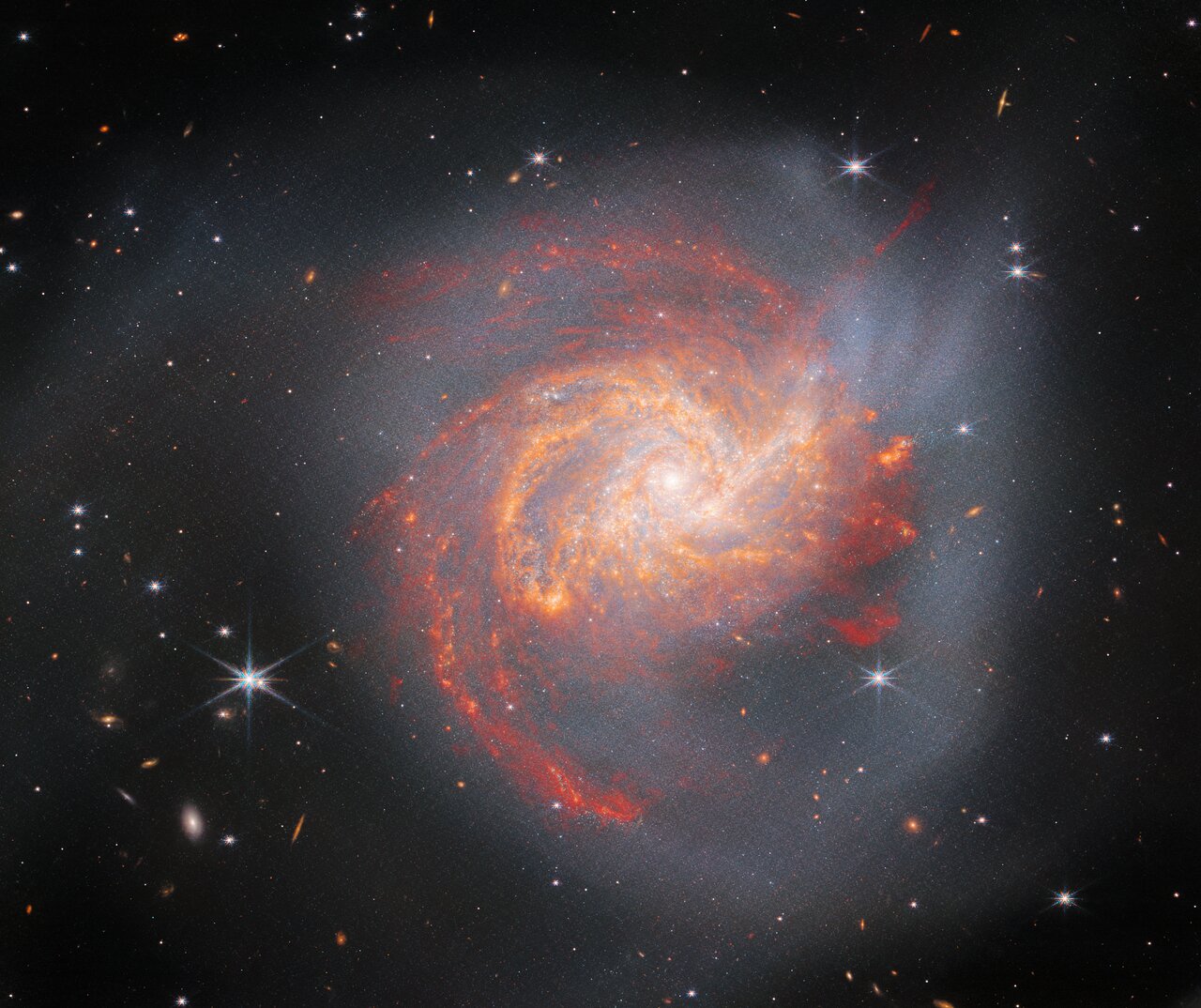About the Object
| Name: | NGC 3256 | |
|---|---|---|
| Distance: |
120 million light years | |
| Constellation: | Vela | |
| Category: | MIRI NIRCam Picture of the Month | |
Coordinates
| Position (RA): | 10 27 51.76 |
|---|---|
| Position (Dec): | -43° 54' 10.47" |
| Field of view: | 2.20 x 1.84 arcminutes |
| Orientation: | North is 53.0° left of vertical |
Colours & filters
| Band | Wavelength | Telescope |
|---|---|---|
| Infrared | 1.5 μm | James Webb Space Telescope NIRCam |
| Infrared | 2.0 μm | James Webb Space Telescope NIRCam |
|
Infrared
PAH | 3.35 μm | James Webb Space Telescope NIRCam |
| Infrared | 5.6 μm | James Webb Space Telescope MIRI |
| Infrared | 4.44 μm | James Webb Space Telescope NIRCam |
|
Infrared
PAH | 7.7 μm | James Webb Space Telescope MIRI |
| Infrared | 15 μm | James Webb Space Telescope MIRI |
Clash of the Titans
The peculiar galaxy NGC 3256 dominates this image from the NASA/ESA/CSA James Webb Space Telescope. This Milky Way-sized galaxy lies about 120 million light-years away in the constellation Vela, and is a denizen of the Hydra-Centaurus Supercluster.
NGC 3256 may seem peaceful, a swirl of tightly entwined spiral arms set in a hazy cloud of light, but this image shows the aftermath of an ancient cosmic clash. This distorted galaxy is the wreckage of a head-on collision between two equally massive spiral galaxies which astronomers estimate to have met around 500 million years ago. The tumultuous past of NGC 3256 is captured in the long tendrils of shining dust and stars which extend outwards from the main body of the galaxy. The striking red and orange regions spread across the galaxy contain young stars created in the merger that are irradiating small dust grains, which then emit infrared light that is captured in astonishing detail by Webb’s instruments. Further out, there are extended tidal features, which are mostly stars pulled out of the galaxies when they collided.
If you were asked to picture a galaxy collision, you might picture stars careening into one another with catastrophically explosive results. In reality, the spaces between the stars in a galaxy are vast; when galaxies collide, their clouds of stars pass through one another and mingle like two clouds of smoke. The gas and dust in colliding galaxies does interact, however, and with spectacular results. The galactic collision that created NGC 3256 triggered a luminous burst of star formation that can be seen in the brightest portions of this image. These infant stars shine most brightly at infrared wavelengths, light which can penetrate through obscuring dust in the galaxy, and which makes the stars perfect subjects for Webb.
This observation is one of several which take a detailed look at the physics of star formation and black hole growth in nearby merging galaxies, hoping to transform astronomers' understanding of galactic evolution. Capturing a selection of luminous infrared galaxies like NGC 3256 will help the astronomical community to understand how Webb can unravel the complex histories of nearby star-forming galaxies.
This image contains data from Webb’s Near-InfraRed Camera and Mid-InfraRed Instrument, which — as the names suggest — capture NGC 3256 in stunning detail at infrared wavelengths. Previous observations of NGC 3256 with the NASA/ESA Hubble Space Telescope revealed this cosmic collision at visible wavelengths, and Hubble and Webb observations are shown side-by-side using the slider tool here.
[Image Description: A large, face-on spiral galaxy. The core is radiating very brightly. Streaks of dust glow intensely red, in the centre and across most of the galaxy. This gas is surrounded by a dark grey halo made of the galaxy’s stars. The halo stretches out into a tidal tail at the upper-left, and another at the bottom. Small stars and galaxies surround the spiral galaxy, on a black background.]
Links
- Slider tool: Hubble and Webb's views of NGC 3256
- Video: Pan of NGC 3256
- Video: Zoom into NGC 3256
- Video: Hubble and Webb's views of NGC 3256
ESA/Webb, NASA & CSA, L. Armus, A. Evans
About the Image
| Id: | potm2306a | |
|---|---|---|
| Type: | Observation | |
| Release date: | 3 July 2023, 06:00 | |
| Size: | 4206 x 3528 px | |




